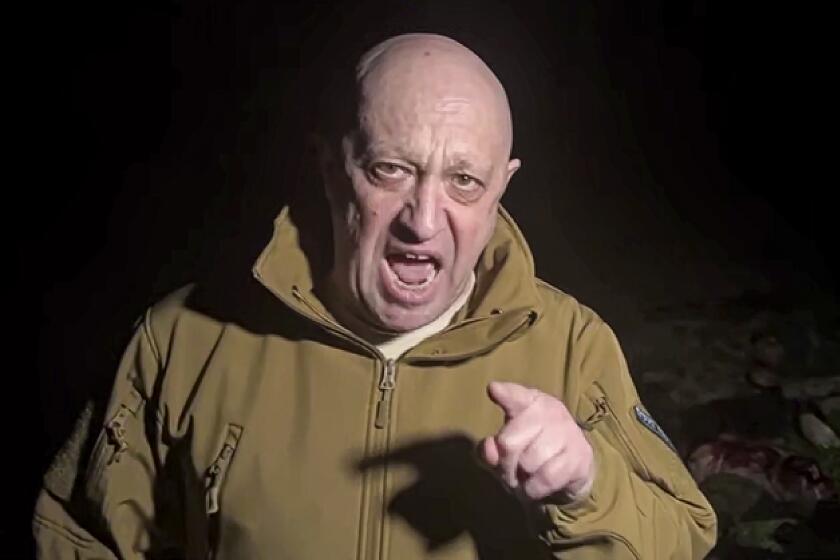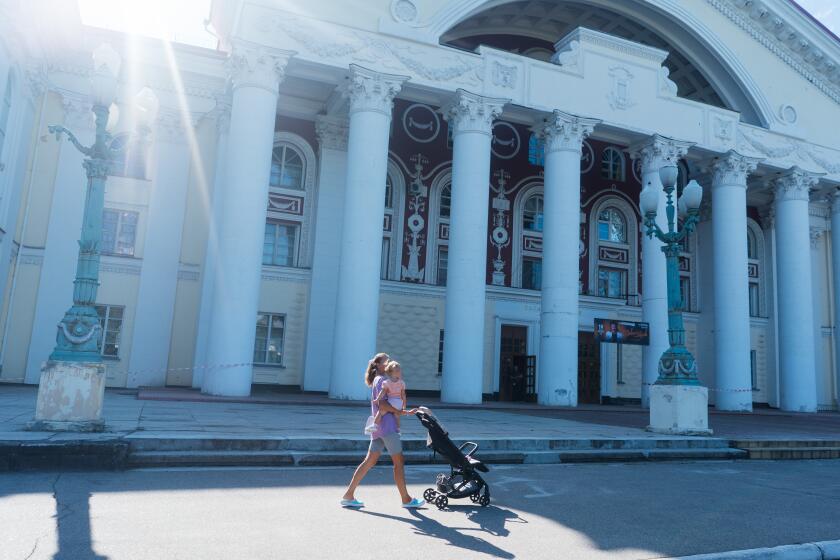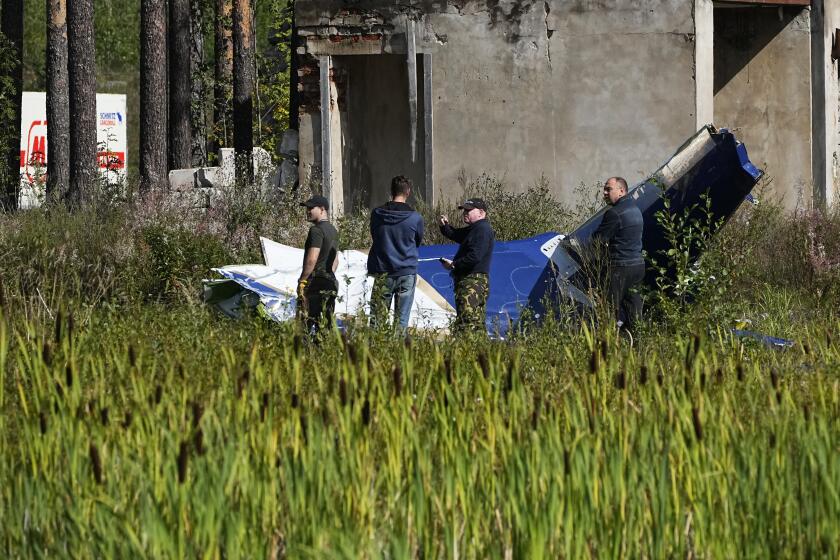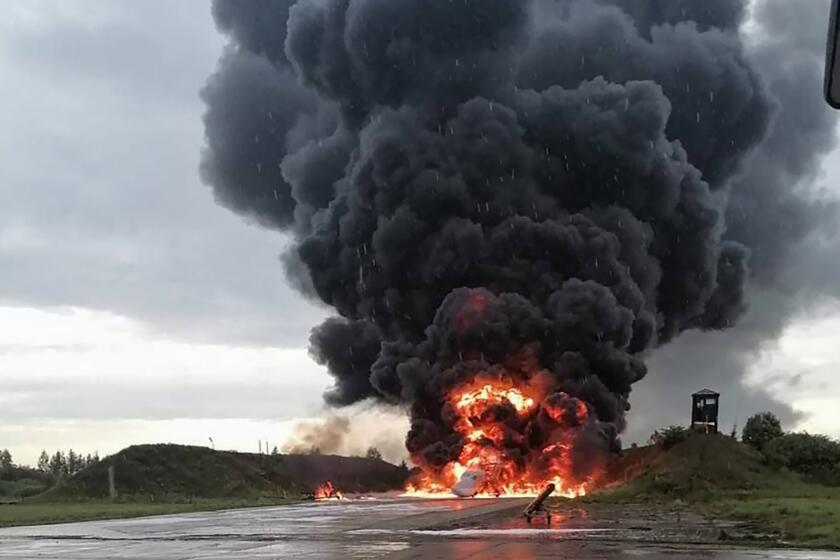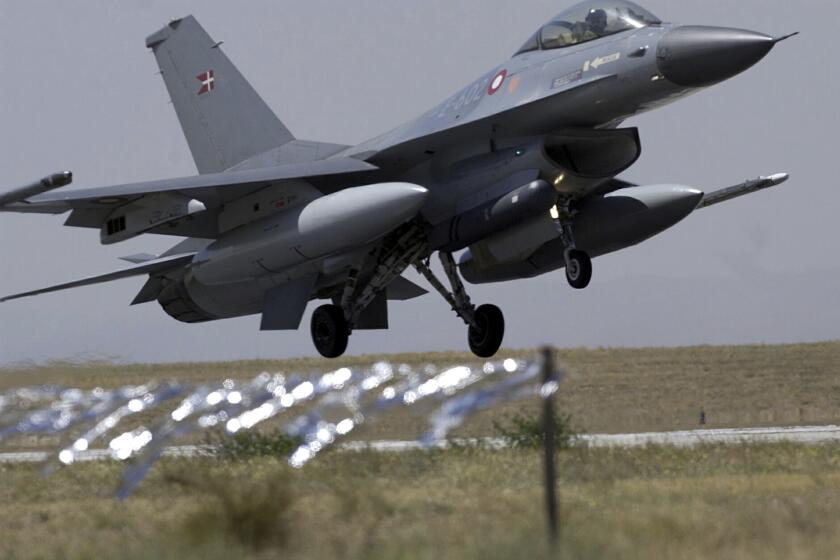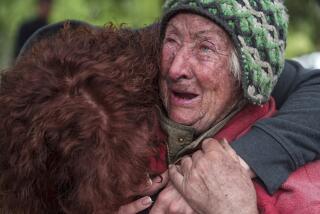Evacuation order in northeast Ukraine finds few followers as fighting nears
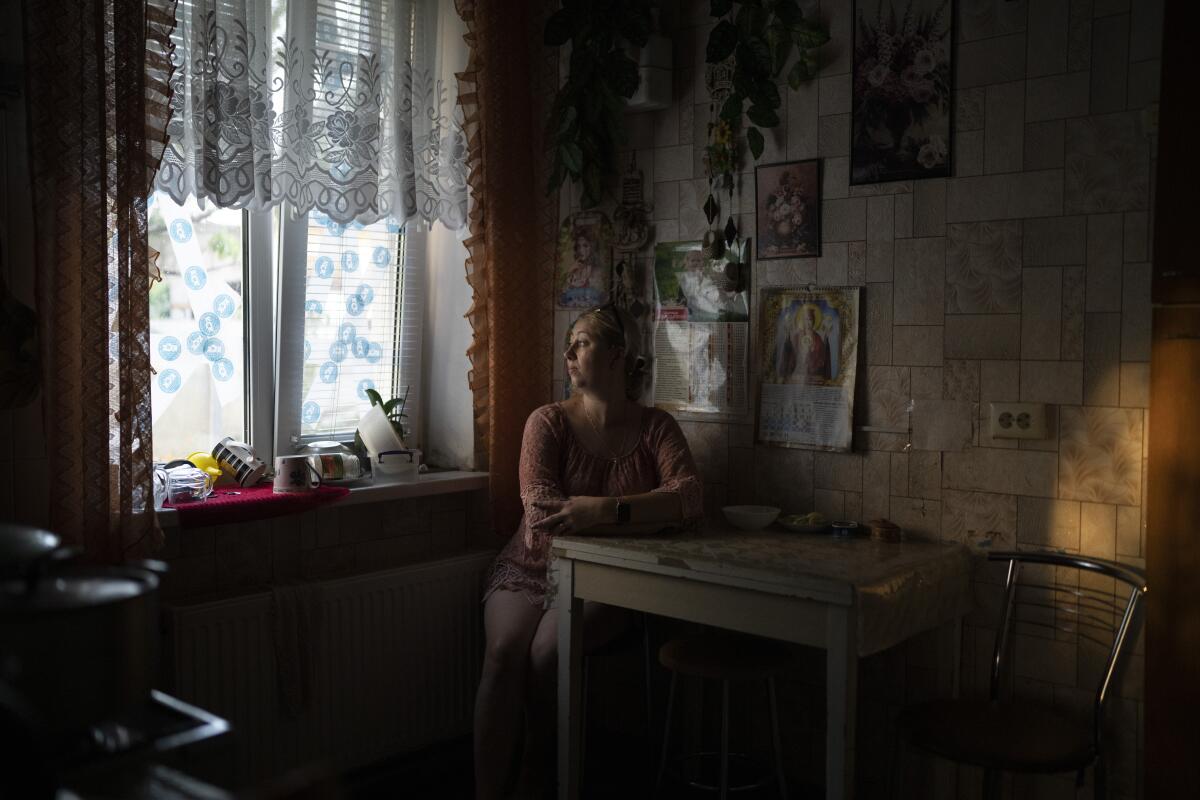
- Share via
KUPIANSK, Ukraine — The thunder of mortar fire echoes in the distance as 5-year old David approaches his mother with an innocent request: Can he play with the baseball bat a relative gave him as a gift?
Valeria Pototska rolls her eyes and tells her son no for the umpteenth time. It’s a toy for big kids, she says. The boy, who doesn’t so much as flinch when the weapons not far from their town in northeast Ukraine shoot off more rounds, pouts and pedals away on his bicycle.
Other neighborhood children frolic in a playground in Kupiansk-Vuzlovyi, seemingly oblivious of the war unfolding about six miles away. Ukrainian authorities this month ordered a mandatory evacuation of the village and three dozen other populated areas as war returned to Kharkiv province. So far, most residents have refused to go as the battle inches closer to their backyards.
“It’s normal,” Pototska said of the soundtrack of weapons that punctuates the monotony of their daily lives.
Olena Kanivets, a friend sitting beside her, nods and takes a drag on a cigarette. “It’s the strong who took the decision to leave,” Kanivets said.
The Aug. 10 evacuation directive applies to 37 settlements that Russian soldiers occupied early in the 18-month-old war. A Ukrainian counteroffensive liberated them in September, lifting the invaded country’s spirits. Citing a Russian attempt to push back into the area, the Kupiansk district military administration told roughly 12,000 residents to seek safety elsewhere.
Russia confirms Wagner mercenary chief Yevgeny Prigozhin, who led a failed mutiny against Russian President Putin’s military, died in a plane crash.
Only a few hundred have heeded the warning. Among the thousands who haven’t, some are paralyzed by the daunting task of relocating. Others said they had considered the hardships of displacement and decided to brave the renewed hostilities instead. Many signed documents stating that they were staying at their own risk.
Their reasons range from the existential to the routine. Fear of encountering poverty and loneliness in expensive faraway cities. Reluctance to give up homes in which they invested their life savings for a crowded shelter. Needing more time to tidy the garden or tend to livestock.
The city of Kupiansk, which also was occupied by the Russians for more than six months last year, is under a partial evacuation order now. Katarina Chesta, a school administrator there, said she plans to stay put even if the order is extended citywide because she is tired of running away from war.
When Russia invaded eastern Ukraine in 2014, Chesta fled the port city of Mariupol under fire and ended up in Kupiansk, where her parents lived. The 39-year-old refuses to pack up and move again.
A Ukrainian city grapples over whether to rename its history museum, currently named after a great-uncle of warlord Yevgeny Prigozhin
Russian airstrikes frequently target Kupiansk. They hit the city’s main school building in October and December, so Chesta is preparing an online curriculum for the new academic year.
“Maybe it’s just the way I am,” she said, sitting in her office wearing an immaculate white dress and her hair styled in an elegant updo. “Some people must stay here to be patriots for the city, to develop it, to survive.”
Kharkiv province, which borders Russia, reemerged as a combat hot spot in mid-July. That’s when the Russian military began assembling assault troops, tank units and other resources in the direction of Kupiansk, hoping to put pressure on Ukrainian troops fighting farther south and to recapture the territory Ukraine won back, according to Ukrainian military officials.
Ukrainian military officials say their forces have kept the Russians from advancing, but there is intense fighting on the outskirts of Synkivka, a village about nine miles from Kupiansk.
Putin finally speaks about Russian mercenary Wagner chief Yevgeny Prigozhin, who is presumed to have died in a plane crash after staging a failed coup.
Illustrating the dangers for the local population, they said Russian units have shelled civilian infrastructure and homes while hunting for Ukrainian soldiers, who fight concealed in the wooded and agricultural landscape. The near-constant shelling kills several residents a week, according to the Kupiansk military administration.
Evacuated residents are taken to a shelter in Kharkiv, the provincial capital and Ukraine’s second-largest city. Red Cross volunteers say the number requesting to relocate spiked in places that received more intense bombing, but many locals still linger.
“Until the moment shelling hits close, people refuse to leave,” volunteer Volodymyr Fedulenko said.
For Oleksandr Ivanovich, 70, that moment came when a shell hit his house in the village of Hryshivka and left the roof in tatters. He was plucking weeds from the front porch at the time. “What to say — it is very painful to leave my home,” Ivanovich said.
Ukraine media say a pair of drone attacks on air bases deep inside Russia were the work of Ukrainian saboteurs backed by intelligence services.
Tatiyana Shapavalova, 59, who lives two doors away, boarded an evacuation van along with her neighbor. She thought their part of Ukraine would stay comparatively peaceful after the Russians withdrew from most of Kharkiv province last year, but an Aug. 13 artillery attack proved her wrong.
“We had hoped the Ukrainian army would push the Russians further away, but every day we hear them coming closer and closer,” Shapavalova said.
Liudmyla Yermyichuk, a resident of the village of Kivsharivka, asked to be evacuated with her 84-year-old mother. Her sister decided to stay behind. “They are planning to clean their garden, and then they will maybe go to Kharkiv,” she said from the Red Cross base in Kupiansk.
In the villages closest to the front line, residents have told volunteer Fedulenko that they don’t want to abandon their farm animals. They spend most of their time in basement shelters below razed houses, he said.
Start your day right
Sign up for Essential California for the L.A. Times biggest news, features and recommendations in your inbox six days a week.
You may occasionally receive promotional content from the Los Angeles Times.
“I have to tell them, ‘Your life is more important than your chickens,’” he said.
In Kupyansk-Vuzlovyi. the long war has created an atmosphere that blends the placid and the deadly. The roar of artillery fire sporadically disturbs the soft rustle of leaves in the late summer breeze. Municipal workers diligently mow the lawn next to bombed-out school buildings.
Residents who lived under occupation for half a year said the experience was terrifying. “Russians acted like kings,” Pototska said. Many said they would evacuate if the return of Moscow’s troops appeared imminent but until then would hold on to hope of Ukrainian forces defeating them.
Kanivets, Pototska’s friend, sent her 12-year-old son, Yaroslav, to a 10-day summer camp in western Ukraine “to give him a break” from the shelling. The war forced him to grow up very quickly, but “he has friends here, it’s his home, so I think its better to stay,” she said. “He’s not scared.”
NATO member Norway will reportedly donate F-16 fighter jets to Ukraine, whose forces are embroiled in a difficult counteroffensive against Russia.
Four months ago, Natalia Rosolova’s son Dmytro, 14, begged her to leave after a night of heavy shelling. “We need to stay for a while longer,” she told him.
Rosolova, 38, recalled the conversation as an an air-raid alarm rang out in their neighborhood. She works as a medic, and “there are very few of us left here,” she said.
If a time comes when the family must flee, their bags are packed and ready to grab from Dmytro’s bedroom.
“Maybe I’m not strong enough to make such difficult decisions,” Rosolova said, tears welling in her eyes. “But I’m not an enemy of my children. If there will be a need to leave, we will leave.”
More to Read
Sign up for Essential California
The most important California stories and recommendations in your inbox every morning.
You may occasionally receive promotional content from the Los Angeles Times.
